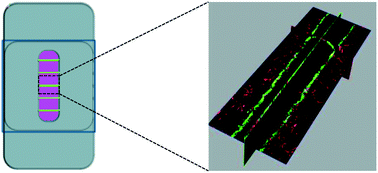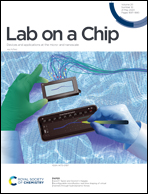A new microfluidic model that allows monitoring of complex vascular structures and cell interactions in a 3D biological matrix†
Abstract
Microfluidic organ-on-a-chip designs are used to mimic human tissues, including the vasculature. Here we present a novel microfluidic device that allows the interaction of endothelial cells (ECs) with pericytes and the extracellular matrix (ECM) in full bio-matrix encased 3D vessel structures (neovessels) that can be subjected to continuous, unidirectional flow and perfusion with circulating immune cells. We designed a polydimethylsiloxane (PDMS) device with a reservoir for a 3D fibrinogen gel with pericytes. Open channels were created for ECs to form a monolayer. Controlled, continuous, and unidirectional flow was introduced via a pump system while the design facilitated 3D confocal imaging. In this vessel-on-a-chip system, ECs interact with pericytes to create a human cell derived blood vessel which maintains a perfusable lumen for up to 7 days. Dextran diffusion verified endothelial barrier function while demonstrating the beneficial role of supporting pericytes. Increased permeability after thrombin stimulation showed the capacity of the neovessels to show natural vascular response. Perfusion of neovessels with circulating THP-1 cells demonstrated this system as a valuable platform for assessing interaction between the endothelium and immune cells in response to TNFα. In conclusion: we created a novel vascular microfluidic device that facilitates the fabrication of an array of parallel soft-channel structures in ECM gel that develop into biologically functional neovessels without hard-scaffold support. This model provides a unique tool to conduct live in vitro imaging of the human vasculature during perfusion with circulating cells to mimic (disease) environments in a highly systematic but freely configurable manner.



 Please wait while we load your content...
Please wait while we load your content...